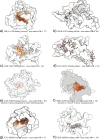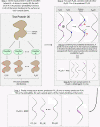Local functional descriptors for surface comparison based binding prediction
- PMID: 23176080
- PMCID: PMC3585919
- DOI: 10.1186/1471-2105-13-314
Local functional descriptors for surface comparison based binding prediction
Abstract
Background: Molecular recognition in proteins occurs due to appropriate arrangements of physical, chemical, and geometric properties of an atomic surface. Similar surface regions should create similar binding interfaces. Effective methods for comparing surface regions can be used in identifying similar regions, and to predict interactions without regard to the underlying structural scaffold that creates the surface.
Results: We present a new descriptor for protein functional surfaces and algorithms for using these descriptors to compare protein surface regions to identify ligand binding interfaces. Our approach uses descriptors of local regions of the surface, and assembles collections of matches to compare larger regions. Our approach uses a variety of physical, chemical, and geometric properties, adaptively weighting these properties as appropriate for different regions of the interface. Our approach builds a classifier based on a training corpus of examples of binding sites of the target ligand. The constructed classifiers can be applied to a query protein providing a probability for each position on the protein that the position is part of a binding interface. We demonstrate the effectiveness of the approach on a number of benchmarks, demonstrating performance that is comparable to the state-of-the-art, with an approach with more generality than these prior methods.
Conclusions: Local functional descriptors offer a new method for protein surface comparison that is sufficiently flexible to serve in a variety of applications.
Figures










Similar articles
-
Binding ligand prediction for proteins using partial matching of local surface patches.Int J Mol Sci. 2010;11(12):5009-26. doi: 10.3390/ijms11125009. Epub 2010 Dec 6. Int J Mol Sci. 2010. PMID: 21614188 Free PMC article.
-
Structural descriptor database: a new tool for sequence-based functional site prediction.BMC Bioinformatics. 2008 Nov 25;9:492. doi: 10.1186/1471-2105-9-492. BMC Bioinformatics. 2008. PMID: 19032768 Free PMC article.
-
Using structural motif descriptors for sequence-based binding site prediction.BMC Bioinformatics. 2007 May 22;8 Suppl 4(Suppl 4):S5. doi: 10.1186/1471-2105-8-S4-S5. BMC Bioinformatics. 2007. PMID: 17570148 Free PMC article.
-
Characterization and prediction of protein interfaces to infer protein-protein interaction networks.Curr Pharm Biotechnol. 2008 Apr;9(2):67-76. doi: 10.2174/138920108783955191. Curr Pharm Biotechnol. 2008. PMID: 18393863 Review.
-
Interaction-site prediction for protein complexes: a critical assessment.Bioinformatics. 2007 Sep 1;23(17):2203-9. doi: 10.1093/bioinformatics/btm323. Epub 2007 Jun 22. Bioinformatics. 2007. PMID: 17586545 Review.
Cited by
-
Visualizing Validation of Protein Surface Classifiers.Comput Graph Forum. 2014 Jun;33(3):171-180. doi: 10.1111/cgf.12373. Comput Graph Forum. 2014. PMID: 25342867 Free PMC article.
References
-
- Kahraman A, Morris RJ, Laskowski RA, Favia AD, Thornton JM. On thediversity of physicochemical environments experienced by identical ligands in binding pockets of unrelated proteins. Proteins. 2010;78(5):1120–1136. doi: 10.1002/prot.22633. [ http://www.ncbi.nlm.nih.gov/pubmed/19927322] - DOI - PubMed
-
- Tuytelaars T, Mikolajczyk K. Local invariant feature detectors: a survey. Foundations Trends®;in Comput Graph Vision. 2007;3(3):177–280. doi: 10.1561/0600000017. [ http://dx.doi.org/10.1561/0600000017] - DOI - DOI
-
- Mikolajczyk K, Schmid C. A performance evaluation of local descriptors. IEEE PAMI. 2005;27(10):1615–1630. [ http://dx.doi.org/10.1109/TPAMI.2005.188] - DOI - PubMed
-
- Lowe DG. Distinctive image features from scale-invariant keypoints. Int J Comput Vision. 2004;60(2):91–110. [ http://dx.doi.org/10.1023/B:VISI.0000029664.99615.94] - DOI
-
- Lowe DG. ICCV. Washington: IEEE Computer Society; 1999. Object recognition from local scale-invariant features; pp. 1150–1150. [ http://doi.ieeecomputersociety.org/10.1109/ICCV.1999.79041] - DOI
Publication types
MeSH terms
Substances
Grants and funding
LinkOut - more resources
Full Text Sources

